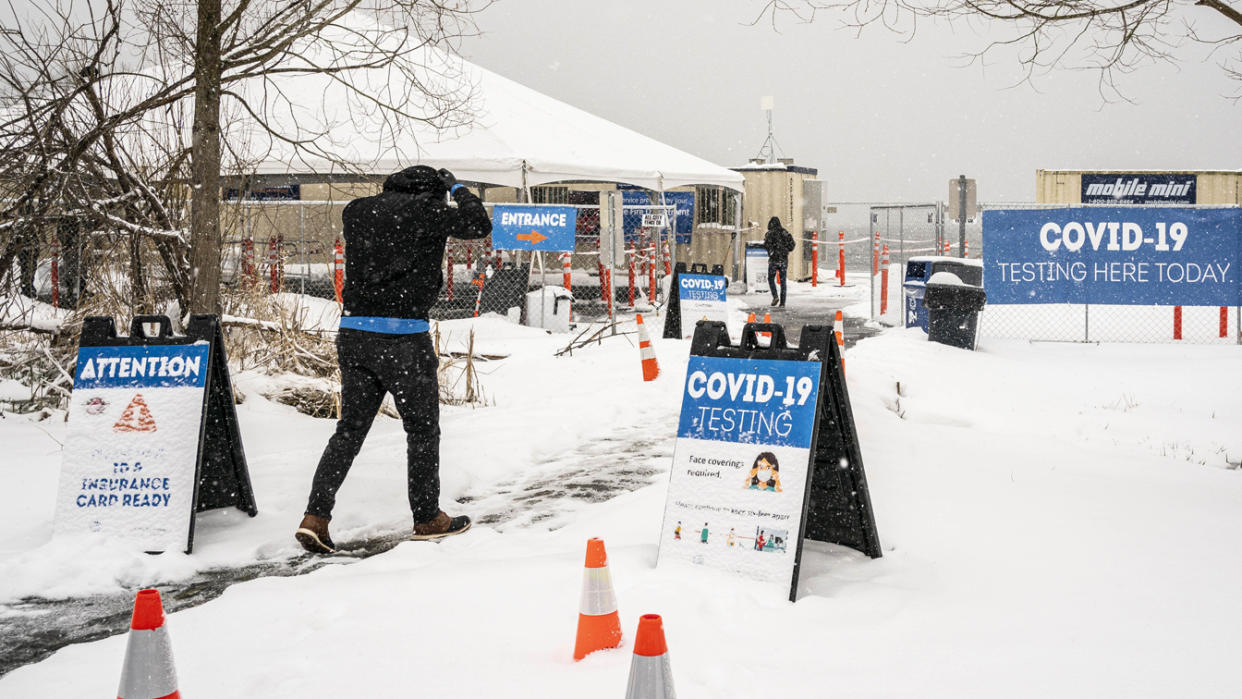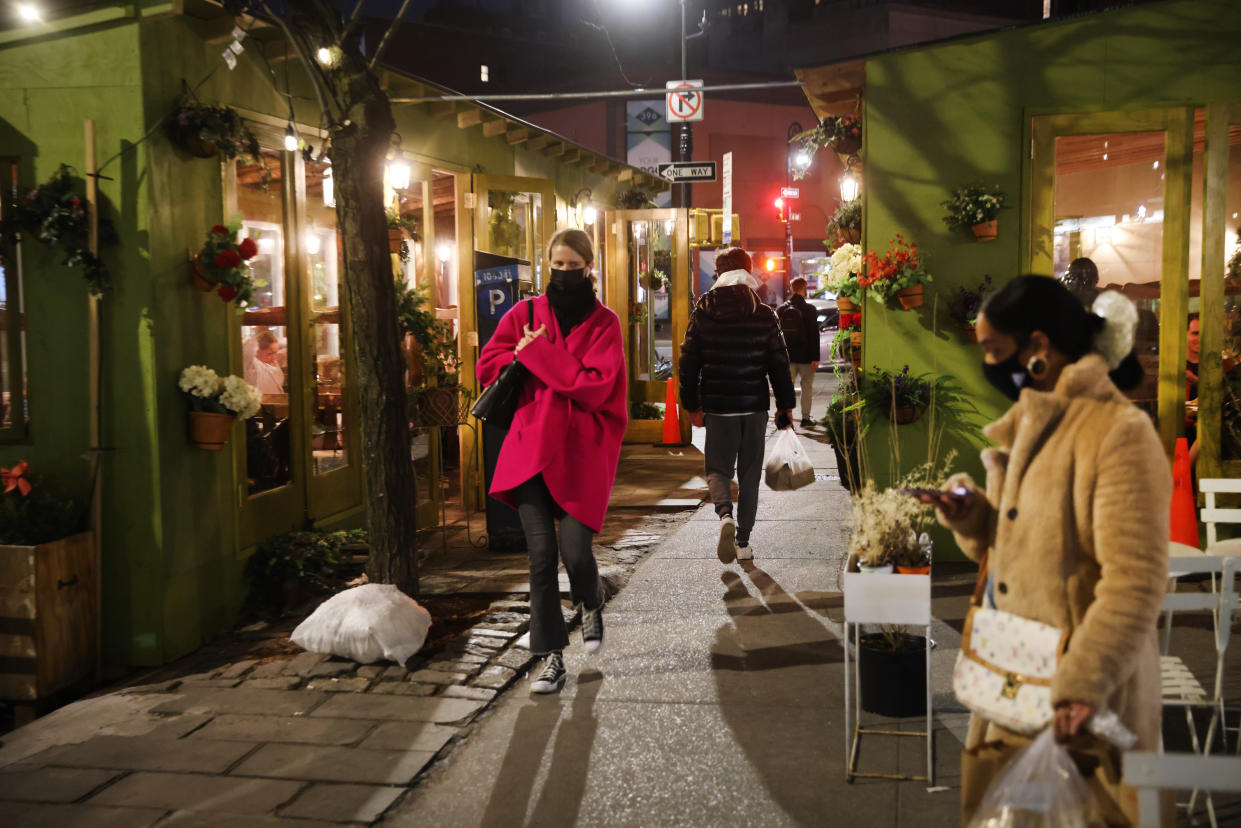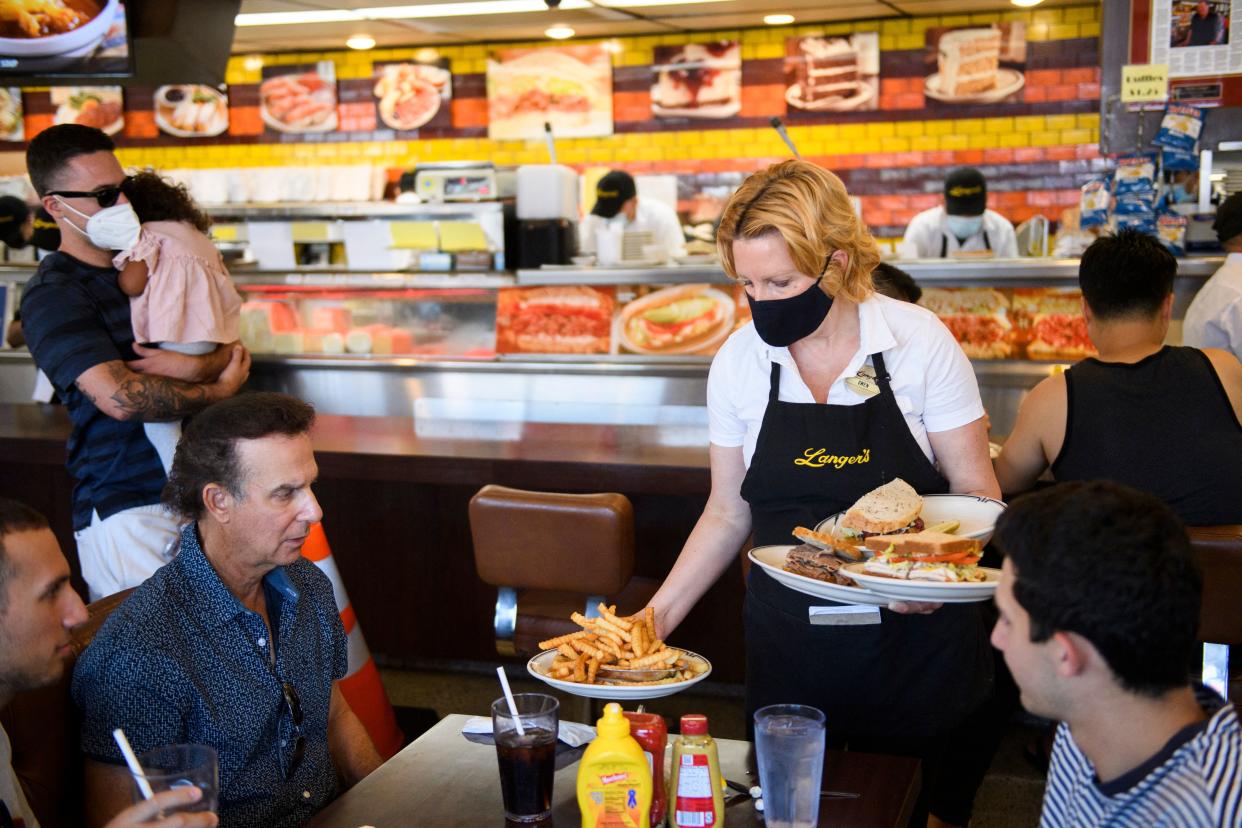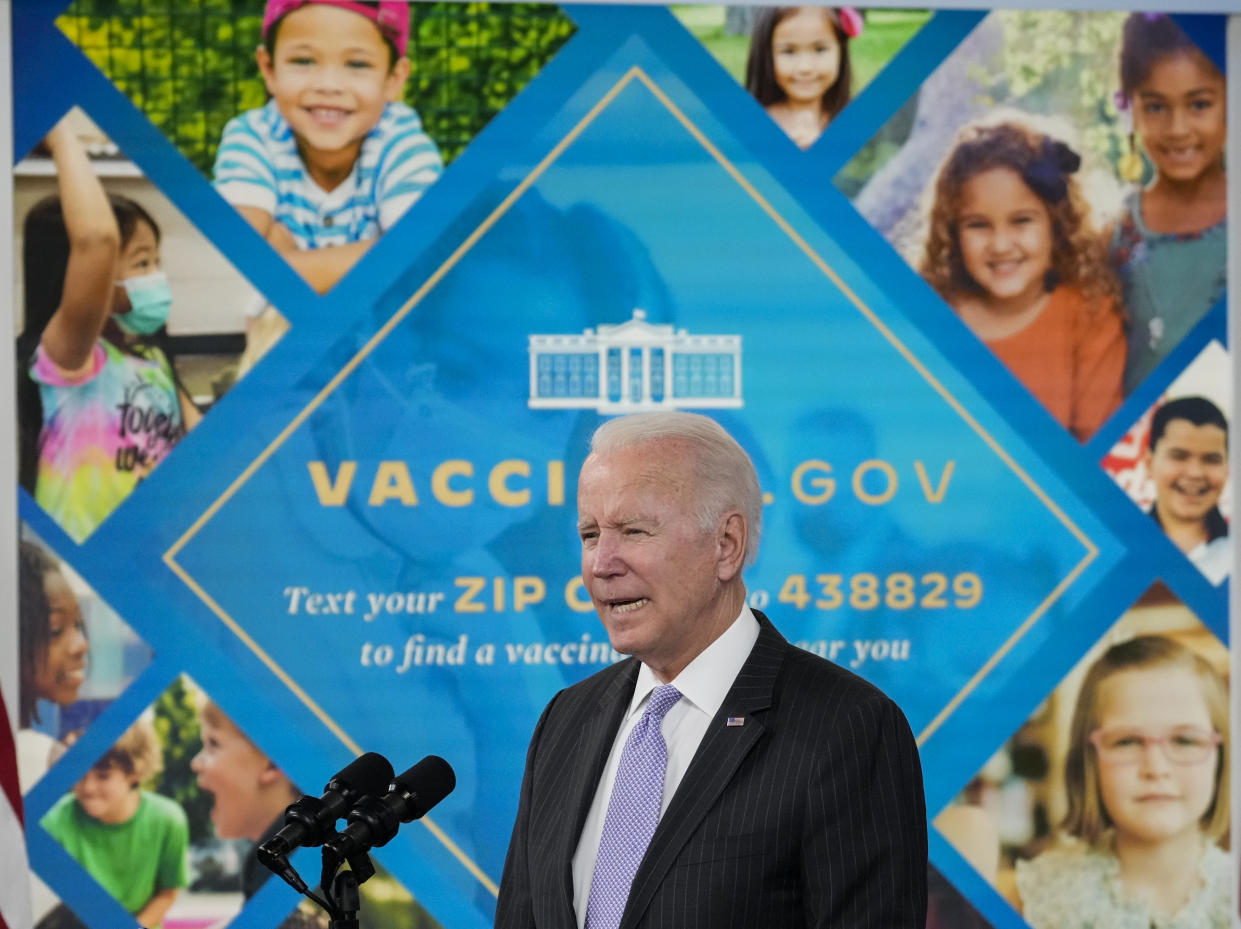Poll: As winter COVID surge begins, 74 percent of Americans say their lives have returned to 'normal'
Even though the COVID-19 pandemic continues to rage on, nearly three-quarters of Americans (74 percent) now say their lives have returned to “normal,” according to a new Yahoo News/YouGov poll.
It’s a number that underscores both the progress made possible by safe and effective vaccines and the challenges ahead as the holidays approach and yet another winter wave gets underway in the United States.
The survey of 1,696 adults, which was conducted from Nov. 17 to 19, found that only 15 percent say that things “never stopped being normal” for them — a reminder of just how profoundly the virus has disrupted American life.
Yet as the U.S. pandemic enters its 21st month, most Americans now characterize their own lives as either "very normal" (21 percent) or "somewhat normal" (53 percent), considering “the impact of COVID-19.”

Far fewer say their lives are either “not very normal” (19 percent) or “not normal at all” (7 percent).
After falling nationally for more than a month, COVID-19 cases are surging again in places with cooler weather that were spared the worst of the initial Delta spike in the U.S., which hit undervaccinated Southern states hardest this summer. Hospitalizations, up 6 percent nationwide over the last two weeks, are beginning to rise, too.
In that light, a return to “normal” may seem premature — and for many, it very well could be. A full 70 percent of unvaccinated Americans, for instance — the people who continue to account for nearly all COVID hospitalizations and deaths — describe their own lives as normal, and about a quarter of them say their lives are “very normal” (25 percent) or “never stopped” being normal to begin with (27 percent). That’s more than the number of vaccinated Americans who say the same (19 percent and 8 percent, respectively).
Likewise, nearly two-thirds of unvaccinated Americans (65 percent) now say that COVID poses either a “small” threat (31 percent) or “no” threat (34 percent) to them personally, and just 42 percent of unvaccinated Americans — compared to 63 percent of fully vaccinated Americans — say they wear a mask in public always or most of the time.
This suggests that in many cases, the people with the least protection against COVID are also the ones being the least careful about it — a dynamic that could make the coming winter wave more difficult and deadly than it needs to be.
At the same time, however, it’s important to note that 71 percent of U.S. adults have been fully vaccinated, according to the Centers for Disease Control and Prevention — and for them, returning to normal was both the point and the promise of getting vaccinated in the first place.
The poll shows that promise is being fulfilled, as vaccinated Americans learn to “live with” COVID.
Asked “why your life is back to normal again,” 57 percent of Americans — which represents nearly everyone who says their lives stopped being normal because of COVID-19 but now say things have returned to normal again — mention vaccines. Given the chance to select from a series of reasons “all that apply,” 38 percent of respondents cited the reason as being “I am vaccinated,” 8 percent cited “the children in my life are vaccinated,” 21 percent cited “the seniors in my life are vaccinated” and 13 percent cited “I got a booster shot.”

Asked on a follow-up question to name the single most important reason why their own lives are back to normal, 30 percent of Americans choose some aspect of vaccine availability — far more than choose “cases are low in my community” (4 percent); “businesses are fully reopened in my community” (7 percent); “I no longer have to wear a mask in public” (5 percent); “I know I can get a life-saving treatment if COVID makes me sick” (3 percent); “schools are open again” (3 percent); or “I’ve already had COVID” (4 percent).
As a result, behavior has changed dramatically over the past year — including a near doubling in reports of unmasked gatherings. In October 2020, 26 percent of registered voters said they "remove[d] their mask outdoors with people who aren't members of [their] immediate family" every day or more than once a week; today, 50 percent of registered voters say they do.
Back then, 19 percent of registered voters also said they "removed their mask indoors with people who aren't members of [their] immediate family" every day or more than once a week; today, 38 percent of registered voters say they do.
Similarly, the number of registered voters who now say they eat indoors at a restaurant (31 percent) and work unmasked in close proximity to others (32 percent) at least once a week is nearly twice as high as last October (17 percent and 18 percent, respectively).
And while only 30 percent of registered voters said they were planning to gather indoors with family and friends last Thanksgiving, 57 percent now say that’s how they’re planning to celebrate this year.
As the hypercontagious Delta variant continues to spread across the Northeast and Upper Midwest — and as protection from the initial vaccine doses wears off somewhat — it’s reasonable to wonder (and worry) what effect increased indoor, unmasked gatherings will have on COVID rates this holiday season. Just one-third (34 percent) of fully vaccinated Americans say they’ve already received a booster; less than half of seniors (49 percent) say the same. Along with lack of caution among the unvaccinated, waning immunity could exacerbate the U.S. winter wave.

Yet even as they restore some semblance of normalcy in their own lives, most Americans (55 percent) continue to wear masks in public “most” or “all of the time,” and even more (71 percent) say “no” when asked if the pandemic “is over in the U.S.” Only 16 percent say yes.
Most Americans also think the pandemic will get worse (44 percent) or stay the same (39 percent) this fall and winter; just 16 percent think it will get better. Asked how long they envision wearing a mask after they’re no longer required, just 29 percent of Americans say “never”; the rest say “whenever I’m in public anywhere” (19 percent); “whenever I’m in public, but just indoor spaces” (24 percent); or “only during flu/COVID/cold season” (13 percent).
How to reconcile the return to normalcy with continued caution and even pessimism about the pandemic itself? Increasingly, Americans are learning to "live with" COVID by distinguishing between the risks to themselves and the risks to others.
Asked whether the pandemic is "over as it pertains to your own life" — as opposed to whether it’s "over in the U.S." — twice as many Americans (32 percent) say yes. And while 41 percent of Americans now describe COVID-19 as posing at least some threat to them personally, more say it still poses at least some threat to "others in your life" (52 percent) or to "America as a whole" (69 percent).
The partisan polarization that has plagued the United States response to COVID persists even here. Among those who voted for former President Donald Trump in the last election, 61 percent say the pandemic is over as it pertains to their own lives, versus just 16 percent of those who voted for President Biden. Likewise, 83 percent of Trump voters say COVID poses no threat or a small threat to them personally; 74 percent say it poses no threat or a small threat to others in their lives; and 62 percent say it poses no threat or a small threat to the United States as a whole.

In contrast, the vast majority of Biden voters say COVID poses a big threat or some threat to the country as a whole (97 percent) or to others in their lives (72 percent), even as far fewer (55 percent) say the same about the personal threat posed by the virus.
That goes a long way toward explaining why 77 percent of Democrats wear a mask most of the time in public, compared to just 31 percent of Republicans — despite the fact that similar numbers of Democrats (76 percent) and Republicans (82 percent) describe their own lives as normal.
Just 58 percent of Republicans say they have received at least one dose of the COVID-19 vaccine, compared to 85 percent of Democrats, while only 32 percent of Republicans say they have already received a booster (13 percent) or would get one if available (19 percent), compared to 73 percent of Democrats (32 percent already received, 41 percent would get one if available).
As for the 26 percent of all Americans who say their lives are still not normal, they remain deeply divided over what the future holds. More say that they cannot envision life “ever being normal again after COVID” (9 percent) or that they’re “not sure” (9 percent) than say that they can envision a return to normalcy (8 percent).
______________
The Yahoo News survey was conducted by YouGov using a nationally representative sample of 1,696 U.S. adults interviewed online from Nov. 17 to 19, 2021. This sample was weighted according to gender, age, race and education, based on the American Community Survey, conducted by the U.S. Bureau of the Census, as well as on 2020 presidential vote (or non-vote) and voter registration status. Respondents were selected from YouGov’s opt-in panel to be representative of all U.S. adults. The margin of error is approximately 2.6 percent.

